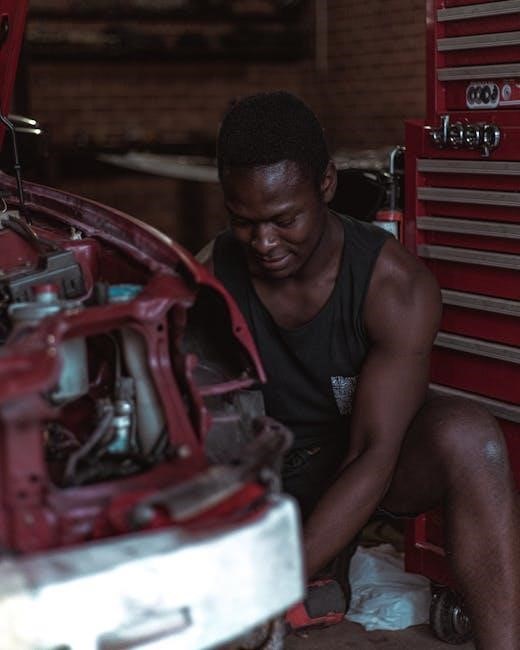Husqvarna 125BV Manual: A Comprehensive Guide
This guide provides a detailed overview of the Husqvarna 125BV, a leaf blower known for its efficiency and user-friendliness. We will explore key aspects, including safety instructions, component functions, starting and stopping, fuel guidelines, maintenance, troubleshooting, and maximizing performance. This comprehensive resource will help you master its operation.
Overview of the Husqvarna 125BV
The Husqvarna 125BV is a handheld blower designed for homeowners seeking a powerful and user-friendly tool for yard maintenance. Combining high blowing force with ergonomic design, the 125BV effectively clears leaves, debris, and grass clippings from various surfaces. Its lightweight construction minimizes strain, while features like the auto-return stop switch and air purge simplify starting.
This blower can also function as a vacuum with the addition of optional collection components. This versatility makes it a valuable tool for gathering leaves and other materials into a collection bag for easy disposal. The Husqvarna 125BV is suitable for various tasks, from clearing driveways and patios to maintaining gardens and lawns.
Designed with the user in mind, the 125BV features intuitive controls and easy access to essential components. Its fuel-efficient engine delivers ample power while minimizing emissions. Regular maintenance, as outlined in this guide, ensures reliable performance and a long lifespan.
Whether you are a first-time user or an experienced homeowner, this guide provides the information needed to operate and maintain your Husqvarna 125BV effectively.
Safety Instructions
Prioritizing safety is crucial when operating the Husqvarna 125BV. Always wear appropriate personal protective equipment, including approved hearing protection, eye protection, and sturdy footwear. Avoid loose clothing or jewelry that could become entangled in the blower’s moving parts;
Before each use, inspect the blower for any damage or loose components. Ensure all guards are in place and functioning correctly. Never operate the blower if any parts are missing or damaged. Be aware of your surroundings and maintain a safe distance from people, animals, and obstacles.
When starting the blower, ensure that the inlet cover is securely closed. Never touch the impeller while the unit is running or until it has completely stopped. Operate the blower only in well-ventilated areas to avoid inhaling exhaust fumes. Do not operate the blower while standing on a ladder or unstable surface.
Always stop the engine before performing any maintenance or repairs. Disconnect the spark plug to prevent accidental starting. Store the blower in a safe and dry location, away from children and unauthorized users. Following these safety instructions will help prevent accidents and ensure safe operation of the Husqvarna 125BV.
Key Components and Their Functions
Understanding the key components of the Husqvarna 125BV is essential for its proper operation and maintenance. The engine provides the power to drive the blower, converting fuel into mechanical energy. The fuel tank stores the fuel mixture, typically a combination of gasoline and two-stroke oil, necessary for the engine to run.
The air filter prevents dirt and debris from entering the engine, ensuring clean air intake for optimal combustion. The carburetor regulates the mixture of air and fuel delivered to the engine, controlling its speed and performance. The choke helps with cold starting by restricting airflow, enriching the fuel mixture.
The primer bulb primes the carburetor with fuel, aiding in starting. The blower fan housing encases the fan impeller, which generates the airflow for blowing or vacuuming. The blower tube directs the airflow, allowing for focused and efficient operation.
The throttle trigger controls the engine speed, allowing the user to adjust the blowing force. The stop switch allows the user to quickly shut off the engine in case of emergency. Familiarizing yourself with these components and their functions will enable you to operate and maintain the Husqvarna 125BV effectively.
Starting and Stopping Procedures
Proper starting and stopping procedures are crucial for the longevity and safe operation of the Husqvarna 125BV. Before starting, ensure the blower is on a flat surface and the blower tube is securely attached. Check the fuel level and add fuel mixture if necessary, using the correct ratio of gasoline to two-stroke oil.
To start a cold engine, engage the choke. Prime the engine by pressing the primer bulb several times until fuel is visible. Pull the starter handle firmly until the engine starts. Once the engine starts, gradually disengage the choke. If the engine is warm, you may not need to use the choke.
Allow the engine to warm up for a few minutes before applying full throttle. To increase the blowing force, squeeze the throttle trigger. For continuous operation, you can use the variable speed control to set a desired speed.
To stop the engine, release the throttle trigger and allow the engine to idle. Then, move the stop switch to the “STOP” position. Ensure the engine has completely stopped before setting the blower down. Following these procedures will ensure safe and efficient operation of your Husqvarna 125BV.
Fuel and Oil Mixture Guidelines
The Husqvarna 125BV requires a precise fuel and oil mixture to ensure optimal performance and engine longevity. Using the correct mixture is vital to prevent engine damage and maintain warranty coverage. Always use high-quality gasoline with an octane rating of 87 or higher. Combine this with a premium two-stroke oil specifically designed for air-cooled engines.
The recommended fuel-to-oil ratio for the Husqvarna 125BV is 50:1. This means mixing 50 parts of gasoline with 1 part of two-stroke oil; For example, if you are using 1 gallon of gasoline, you would add 2.6 ounces of two-stroke oil. It is crucial to measure accurately to avoid engine problems.
Always mix the fuel and oil in a clean, approved fuel container. Start by adding half the amount of gasoline, then add the entire amount of two-stroke oil. Shake the container vigorously to ensure the oil and gasoline are thoroughly mixed. Add the remaining gasoline and shake again.
Never use fuel that has been stored for more than 30 days, as it can degrade and cause engine issues. Always dispose of old fuel properly and store the fuel mixture in a cool, dry place away from direct sunlight. Following these fuel and oil mixture guidelines will help keep your Husqvarna 125BV running smoothly.
Carburetor Adjustment
Proper carburetor adjustment is essential for the Husqvarna 125BV to run efficiently and deliver optimal performance. The carburetor controls the air-fuel mixture that enters the engine, and adjustments may be necessary due to changes in altitude, temperature, or fuel quality. Understanding the adjustment screws is crucial for achieving the correct settings.
The Husqvarna 125BV carburetor typically has three adjustment screws: the low-speed jet (L), the high-speed jet (H), and the idle speed screw (T). The low-speed jet affects the engine’s performance at low RPMs, while the high-speed jet controls the fuel mixture at high RPMs. The idle speed screw adjusts the engine’s idling speed.
Before making any adjustments, ensure the engine is warmed up. Start by adjusting the low-speed jet. Turn the screw clockwise until the engine starts to run poorly, then turn it counterclockwise until it runs smoothly. Next, adjust the high-speed jet similarly, listening for the smoothest engine performance at full throttle.
Finally, adjust the idle speed screw to achieve the correct idling speed, usually specified in the operator’s manual. The goal is to have the engine running smoothly without stalling. If you’re unsure about these steps, consult a qualified technician to avoid damaging the engine. Always make small adjustments and test the engine’s performance after each change.

Maintenance Schedule
A consistent maintenance schedule is crucial for ensuring the longevity and optimal performance of your Husqvarna 125BV. Regular upkeep prevents small issues from escalating into major repairs, saving you time and money in the long run. This schedule outlines the necessary tasks and their recommended intervals.
Daily Maintenance: Before each use, inspect the blower for loose parts or damage. Clean the exterior surfaces to prevent debris buildup. Check the throttle trigger and variable speed control for proper function, replacing any damaged parts.
Weekly Maintenance: Clean the air filter to maintain proper airflow to the engine; A clogged air filter can reduce performance and increase fuel consumption. Also, inspect the cooling system and remove any debris to prevent overheating.
Monthly Maintenance: Check the spark plug for wear or damage and replace it if necessary. Inspect the fuel lines for cracks or leaks and replace them as needed. Clean the blower fan housing to ensure efficient air discharge.
Annual Maintenance: Have a qualified technician inspect the carburetor and make any necessary adjustments. Replace the fuel filter to prevent fuel system clogs. Check and tighten all screws and bolts to ensure they are secure. Following this schedule diligently will keep your Husqvarna 125BV running smoothly for years to come.
Air Filter Maintenance
Maintaining a clean air filter is paramount for the optimal performance and longevity of your Husqvarna 125BV. The air filter prevents dust, dirt, and debris from entering the engine, which can cause wear and damage over time. Regular cleaning or replacement of the air filter ensures proper airflow and prevents engine problems.
To access the air filter, locate the air filter cover, usually positioned on the side of the blower. Remove the cover by unscrewing or unclipping it, depending on the model. Once the cover is removed, carefully take out the air filter.
Inspect the air filter for dirt and debris. If the filter is only slightly dirty, gently tap it to remove loose particles. For more thorough cleaning, wash the filter with warm, soapy water. Rinse the filter thoroughly and allow it to air dry completely before reinstalling it.
If the air filter is heavily soiled, damaged, or cannot be cleaned effectively, it should be replaced with a new one. Ensure that the replacement filter is the correct type for your Husqvarna 125BV.
Reinstall the clean or new air filter into its housing and secure the air filter cover. It is recommended to clean the air filter weekly or more often if operating in dusty conditions. Regular air filter maintenance will keep your blower running efficiently.

Spark Plug Maintenance
Proper spark plug maintenance is essential for ensuring reliable ignition and optimal engine performance in your Husqvarna 125BV. A properly functioning spark plug ignites the fuel-air mixture, enabling the engine to start and run smoothly. Regular inspection, cleaning, and replacement of the spark plug are vital for maintaining its condition.
To access the spark plug, first, ensure that the engine is turned off and has cooled down completely. Locate the spark plug boot, which is usually located on top of the engine. Gently pull the spark plug boot to disconnect it from the spark plug.

Use a spark plug wrench to carefully unscrew and remove the spark plug. Inspect the spark plug for signs of wear, fouling, or damage. A healthy spark plug should have a clean, light brown or gray electrode.
If the spark plug is fouled with carbon deposits, clean it using a wire brush. Check the spark plug gap using a spark plug gap tool. Adjust the gap to the manufacturer’s specified range, typically found in the operator’s manual.
If the spark plug is severely worn, damaged, or the electrode is heavily eroded, replace it with a new spark plug of the correct type. When reinstalling the spark plug, tighten it to the proper torque specification to prevent damage to the cylinder head. Reconnect the spark plug boot securely. Regular spark plug maintenance will ensure easy starting and efficient engine operation.
Troubleshooting Common Issues
Even with proper maintenance, the Husqvarna 125BV may encounter occasional issues. This section provides guidance on troubleshooting common problems to help you resolve them efficiently.

Starting Problems: If the blower fails to start, first ensure that the fuel tank contains fresh fuel mixed at the correct ratio. Check the spark plug for fouling or damage, and clean or replace it if necessary. Verify that the air filter is clean to allow proper airflow. If the engine is flooded, remove the spark plug and pull the starter cord several times to clear excess fuel.
Poor Performance: If the blower starts but runs poorly, check the carburetor settings. Adjust the idle speed and high-speed jets according to the operator’s manual. A dirty air filter can also restrict airflow, leading to reduced power. Inspect the fuel lines for leaks or clogs.
Engine Stalling: Stalling can be caused by various factors. Check the fuel cap vent to ensure it’s not blocked, as this can create a vacuum in the fuel tank. A faulty spark plug or incorrect carburetor settings can also cause stalling.
Excessive Vibration: Excessive vibration may indicate loose components. Inspect the blower tube, fan housing, and engine mounting bolts, and tighten them as needed.
If these troubleshooting steps do not resolve the issue, consult a qualified repair technician for further assistance.




